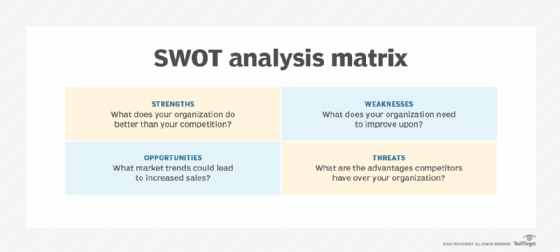What is a SWOT analysis? Definition, examples and how to
SWOT analysis is a framework for identifying and analyzing an organization's strengths, weaknesses, opportunities and threats. These words make up the SWOT acronym.
The primary goal of a SWOT analysis is to increase awareness of the factors that go into making a business decision or establishing a business strategy. To do this, SWOT analyzes the internal and external environment and the factors that can affect the viability of a decision.
SWOT analysis is commonly used by businesses, but also by nonprofit organizations and, to a lesser degree, individuals for personal assessment. SWOT is also used to assess initiatives, products or projects. For example, a chief information officer could use SWOT to help create a strategic business planning template or perform a competitive analysis.
The process increases the possibility of identifying internal and external strengths and weaknesses, and can be used to determine how closely an organization or project is aligned with its goals. Since its creation, SWOT analysis has become a valuable tool for organizations.
The SWOT framework is commonly credited to Albert Humphrey, who tested the approach in the 1960s and 1970s at the Stanford Research Institute. SWOT analysis was initially developed for business and based on data from Fortune 500 companies. Organizations of all types have adopted it as a brainstorming aid for making business decisions.
Why is SWOT analysis important?
The SWOT framework is considered a powerful support for decision-making because it enables an organization to uncover opportunities for success that were previously unarticulated. It also highlights threats before they become overly burdensome.
Overall, SWOT helps to enable better strategic planning processes. It can be used to challenge assumptions and potentially risky business decisions. It encourages an organization to systematically evaluate its own strengths, weaknesses, potential opportunities and even possible threats, leading to a more clear perspective on the organization's position.
Even if an organization has realistic insights into its business internally, it still might not understand external issues, like increased competition or fluctuating demand. In this way, SWOT analysis helps keep an organization grounded in reality.
Conducting a SWOT analysis can, for example, identify a market niche where a business has a competitive advantage. It can also help individuals plot a career path that maximizes their strengths and alert them to threats that could thwart success.
This type of analysis is most effective when it's used to pragmatically recognize and include business issues and concerns. Consequently, SWOT often involves a diverse cross-functional team capable of sharing thoughts and ideas freely. The most effective teams use actual experiences and data -- such as revenue or cost figures -- to build the SWOT analysis.
When should you perform a SWOT analysis?
SWOT analysis is most often used at the start of, or as part of, the strategic planning process. It can also be performed periodically to check current business landscapes and industry trends. The analysis is more effective when used before a key decision-making moment, however. Ideally, this should help to develop business strategies and improve operations while also helping to set more realistic goals.
Elements of SWOT analysis
As its name states, SWOT analysis examines four elements:
- Strengths. Internal attributes and resources that support a successful outcome, such as a diverse product line, loyal customers or strong customer service.
- Weaknesses. Internal factors and resources that make success more difficult to attain, such as a weak brand, excessive debt, or inadequate staffing or training.
- Opportunities. External factors that the organization can capitalize on or take advantage of, such as favorable export tariffs, tax incentives or new enabling technologies.
- Threats. External factors that could jeopardize the entity's success, such as increasing competition, weakening demand or an uncertain supply chain.
This can be further simplified into internal and external factors containing the same information.
A SWOT matrix is often used to organize the items identified under these four elements. The matrix is usually a square divided into four quadrants, with each quadrant representing one of the specific elements. Decision-makers identify and list specific strengths in the first quadrant, weaknesses in the next, opportunities and then threats.

Organizations or individuals doing a SWOT analysis can use various free SWOT analysis templates. These templates are generally variations of the standard four-quadrant SWOT matrix.
How to conduct a SWOT analysis
Conducting a SWOT analysis generally requires decision-makers to first specify the objective they hope to achieve for the business, organization, initiative or individual. Then, they list the strengths and weaknesses, as well as opportunities and threats.
In a list format, this process might end up looking like this:
- Specify the objective.
- Set up and define quadrants.
- Compile and organize ideas for each quadrant.
- Develop a strategy based on insights gathered.
Various tools exist to guide the decision-making process. They frequently provide questions that fall under each of the four SWOT elements.
For example, participants might be asked the following to identify their company's strengths: "What do you do better than anyone else?" and "What advantages do you have?" To identify weaknesses, they might be asked, "Where do you need improvement?" Similarly, they'd run through questions such as, "What market trends could increase sales?" and "Where do your competitors have market share advantages?" to identify opportunities and threats.
Example of a SWOT analysis
The end result of a SWOT analysis should be a chart or list of a subject's characteristics. The following is an example of a SWOT analysis of an imaginary retail employee:
- Strengths. Good communication skills, on time for shifts, handles customers well, gets along well with all departments, physical strength, good availability.
- Weaknesses. Takes long smoke breaks, low technical skills, very prone to spending time chatting.
- Opportunities. Storefront worker, greeting customers and assisting them in finding products, helping keep customers satisfied, assisting customers postpurchase and ensuring buying confidence, stocking shelves.
- Threats. Occasionally missing time during peak business due to breaks, sometimes too much time spent per customer postsale and too much time in interdepartmental chat.
How to use SWOT analysis
SWOT analysis should be used to help an entity gain insight into its current and future position in the marketplace or against a stated goal.
Organizations or individuals using this analysis can see competitive advantages, positive prospects, and existing and potential problems. With that information, they can develop business plans or personal or organizational goals to capitalize on positives and address deficiencies.
Once SWOT factors are identified, decision-makers can assess whether an initiative, project or product is worth pursuing and what is needed to make it successful. As such, the analysis aims to help an organization match its resources to the competitive environment.
SWOT analysis can be used to assess and consider a range of goals and action plans, such as the following:
- Creating and developing business products or services.
- Making hiring, promotion or other human resources decisions.
- Evaluating and improving customer service opportunities and performance.
- Setting business strategies to improve business performance, competitiveness or marketing.
- Making investments in technologies, geographical locations or markets.
SWOT analysis might sometimes be overlooked, but it is a very useful tool. SWOT analysis is also similar to PEST (political, economic, social and technological) analysis, which helps organizations analyze external factors that affect their operations and competitiveness.
SWOT analysis pros and cons
Among the advantages of using a SWOT approach are the following:
- The analysis visualizes the factors most likely to affect whether the business, project, initiative or individual can successfully achieve an objective.
- By involving experienced cross-discipline team members, SWOT analysis can encourage many different perspectives and approaches.
- Such diversity can enable SWOT analysis to expand on each element and expose creative ideas or overlooked problems that might otherwise go unnoticed.
- SWOT analysis can aid in creating roadmaps based on realistic and tangible factors.
- It can be applied to a variety of projects for both businesses and individuals.
Although a SWOT snapshot is important for understanding the many dynamics that affect success, the analysis does have limits, such as the following:
- The analysis might not include all relevant factors because some company weaknesses, strengths, opportunities and threats can be easily overlooked, oversimplified or misunderstood.
- The input for each element can often be empirical or subjective and give a skewed perspective.
- Because it only captures factors at a particular point in time and doesn't allow for how those factors could change over time, the insight that SWOT offers might have a limited shelf life.
Common mistakes with SWOT analysis
Although SWOT analysis can be a powerful strategic tool, there are several common mistakes made with it that can reduce its effectiveness. Examples include the following:
- Lacking objectivity. Downplaying weaknesses and overestimating strengths will lead to inaccurately optimistic assessments.
- Not prioritizing findings. Not all strengths, weaknesses, opportunities and threats are created equal. Treating them as such can lead to making worse strategic decisions.
- Only using it once. SWOT analysis can and should be used multiple times to ensure adherence to project goals and to reveal new and changing elements that could appear in each quadrant.
- Being vague. The more specific a stated goal, strength, weakness, opportunity or threat is, the better an organization will be able to assess its current surroundings and trajectories.
- Conducting SWOT in an isolated section. SWOT analysis should include input from employees, customers, suppliers, industry experts and other stakeholders.
- Only relying on SWOT. SWOT is a valuable tool, but it isn't the only method to improve decision-making abilities.
SWOT analysis is a great method for setting up realistic goals. Learn more about SWOT and additional methods to set up business goals in a step-by-step guide.






